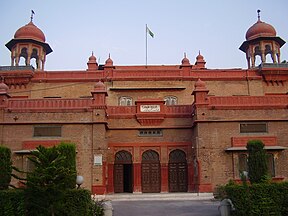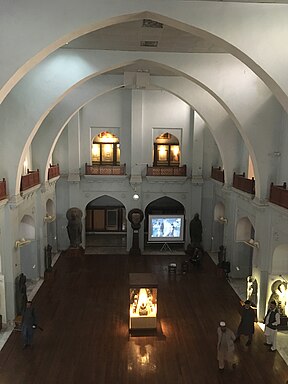Peshawar Museum
This article includes a list ofgeneral references,butit lacks sufficient correspondinginline citations.(May 2021) |
پشاور عجائب گھر | |
The Peshawar Museum is noted for its collection of ancientGandharanart Main hall of the Peshawar Museum | |
 | |
Former name | Victoria Hall |
|---|---|
| Established | 1907 |
| Location | Peshawar, Khyber Pakhtunkhwa,Pakistan |
| Coordinates | 34°00′28″N71°33′30″E/ 34.0077°N 71.5583°E |
| Owner | Government of Khyber Pakhtunkhwa |
| Website | www |
ThePeshawar Museum(Urdu:پشاور میوزیم(colloquial);پشاور عجائب گھر(official)) is amuseumlocated inPeshawar,capital of Pakistan'sKhyber Pakhtunkhwaprovince. The museum houses a collection of Buddhist artwork from the ancientGandhararegion.[1]
Background
[edit]The Peshawar Museum was founded in 1907 as "Victoria Hall," in memory ofQueen Victoria.The two-story building was built in a syncretic architectural style consisting of British, Hindu, Buddhist andMughalIslamic styles.
Initially, the museum had only one exhibition hall, but two more were added in 1969–70. In 2004–05, the museum was further expanded with the construction of a new block with two galleries, two halls for the museum's collection in storage, offices for the provincial directorate of archaeology, a conservation laboratory and a cafeteria. The historic exhibition hall was also renovated at that time.
Collection
[edit]The current collection consists of nearly 14,000 items[citation needed]based onGandhara,Greco-Buddhist,Kushan,Parthian,and Indo-Scythian culture. The collection includes art, sculptures, coins, manuscripts, statues, ancient books, early versions of the Quran, weapons, dresses, jewelry, Kalash effigies, inscriptions, paintings of the Mughal and later periods, household materials and pottery, as well as local and Persian handicrafts.
Gandhara and Greco-Buddhist Art
[edit]
Peshawar Museum has extensive collections ofGandhara artof the Buddhist period, including Buddhist stone sculptures,terracottafigurines, and other Buddhist objects. The display of Gandhara art in the main hall includesBuddha's life stories, miracles, worship of symbols, relic caskets, and individual standing Buddha sculptures. The ethnological objects of that period are also exhibited in the museum.
Numismatics
[edit]
The Peshawar Museum has 8,625 coins, 4,510 of which are pre-Islamic. The main interest of the museum's numismatic collection is that the coins were recovered from archaeological sites, including: Shah-Ji-Ki-Dheri, Shari Bahlol, Takht-i-Bahi and Jamal Garhi. The collections ofBactrian Greek,Indo-Greek, Indo-Scythian, Indo-Parthian and Kushan coins have been published.[5]
Mughal and Persian Islamic Art
[edit]This gallery exhibits wooden facades of mosques, ancient Arabic and Persian inscriptions, fine Multani tiles and ceramics, and the dresses and weapons ofSyed Ahmad Barelviand other historical leaders. The collection also includes Mughal Islamic metal artifacts in bronze and silver, along with calligraphic specimens and scrolls dating back as far as 1224.
Middle Age and British Rule to Present
[edit]This gallery showcases items reflecting on the culture and life of the tribes inKhyber Pakhtunkhwaprovince, includingKalasha Deshlocated in the far north of the province, home to a tribe ofanimistscalled theKalash.The museum features cultural artifacts from the Kailash Valley, along with a collection of weaponry such as swords, daggers, spears, long bows, recurve bows, arrows, shields, muzzle-loading guns, revolvers, pistols and gunpowder boxes.
-
Standing Buddha
-
Seated Bodhisattva
-
Sahri BahlolBuddha, excavated 1909-1910
See also
[edit]Notes
[edit]- ^Desk, Web."Peshawar Museum".paktourismportal.com.Retrieved6 July2022.
{{cite web}}:|last=has generic name (help) - ^Rhi, Juhyung.Identifying Several Visual Types of Gandharan Buddha Images. Archives of Asian Art 58 (2008).pp. 53–56.
- ^The Classical Art Research Centre, University of Oxford (2018).Problems of Chronology in Gandhāran Art: Proceedings of the First International Workshop of the Gandhāra Connections Project, University of Oxford, 23rd-24th March, 2017.Archaeopress. p.45,notes 28, 29.
- ^Chandrasekhar, Anand (14 February 2019)."How you move a priceless 1.5-ton Buddha across continents".SWI swissinfo.ch.
- ^Frontier Archaeology Issues 1 and 2
References
[edit]- Frontier Archaeology Vol.II, 2004, Catalogue of Coins in the Peshawar Museum No.1 Kushan Period (ed. Ali, I), Directorate of Archaeology & Museums
- Frontier Archaeology Vol.IV, 2006, Catalogue of Coins No.2 Indo-Greek and Scytho-Parthian Period (ed. Ali, I), Directorate of Archaeology & Museums





